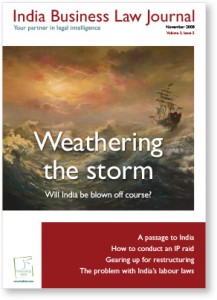The complex aftershocks of the West’s financial emergency may be both blessing and curse for India. Proceed with caution
This issue of India Business Law Journal maintains our focus on how law firms and their clients are adapting to the changing environment wrought by the recent financial tumult. As one lawyer puts it pithily, “If the last year belonged to investors, the next one will belong to creditors.”
Our Cover story (page 17) evaluates the likely impact of the economic turbulence on India and assesses how the country will weather the storm.
For India-focused law firms, the challenge is to retool and reorganize to better undertake the kinds of work that are now being demanded by clients. Enter dispute resolution, restructuring, distressed asset and compliance-related work.
This month’s Spotlight (Gearing up for restructuring, page 25) investigates how Indian and international law firms are rising to this crucial challenge. Some are establishing asset reconstruction teams to deal with the restructuring of portfolios, though to date we know of none that have matched the US firm that has set up a dedicated “financial crisis response team”.

India Business Law Journal
Our coverage finds Indian lawyers representing clients at debt recovery tribunals such as the Board for Industrial and Financial Reconstruction. The body of domestic restructuring law is neither small nor straightforward. It includes the Sick Industrial Companies Act, relief undertakings, Reserve Bank of India regulations on corporate debt restructuring and more. Some practitioners predict the exercise will go beyond brushing up skills and that corporate restructuring and insolvency will blossom into separate legal disciplines.
Crisis or no crisis, there are certain areas of legal practice that seem to be perennially under the spotlight. One such area is intellectual property. This month’s What’s the deal? (page 35) uses a case study of a real life IP raid to illustrate the challenges and complexities of effective IP enforcement in India.
Also under examination in this issue is how long-standing regulatory restrictions are hampering the ability of both law firms and corporations in India to react and reengineer themselves to keep pace with market conditions.
A case in point is India’s overly complex and in many ways antiquated labour laws (Hard labour, page 31). The need for reform was easy to overlook during the boom years, when companies were hiring rather than firing and the onerous regulatory requirements were viewed as inconveniences rather than roadblocks.
How times have changed. Today’s economic environment demands that companies be nimble and flexible. They must have the ability to adapt to changes in demand and adjust their workforces accordingly. Yet from a labour law perspective in India, insolvency is often a cheaper and less troublesome option than even a minor downsizing. Restrictive national and local legislation effectively bars enterprises with more than 100 staff from letting even a single employee go without first obtaining government approval.
One consequence has been a wholesale movement by Indian employers towards recruiting staff on casual rather than permanent contracts. Businesses, and the employees whom the laws were designed to protect, are suffering as a result.
Taken all together, this month’s issue of India Business Law Journal cries out for the hiatus in the economic frenzy to be seized as an opportunity to deepen reform. Increased regulation and tighter scrutiny of financial institutions appear necessary and inevitable. Proceeding with reform without stifling innovation requires maintaining a fine balance.
One area in which there is near unanimous agreement on the need for change is the corporate structures of law firms and other professional services providers. Writing in this month’s Vantage point (Off with the shackles, page 24), Vikrant Pachnanda of Perot Systems argues powerfully in favour of the swift enactment of India’s languishing Limited Liability Partnership Bill.
Pachnanda holds that the lack of an LLP structure in India has impeded the momentum needed to modernize the professional services sector. He argues that LLP structures will have a positive impact on the legal profession. In particular, he says, lifting the 20-partner ceiling of partnership structures will enable Indian law firms to compete effectively with international firms.
With a potential plethora of M&A opportunities becoming available around the world as asset prices tumble, the ability of Indian law firms to compete effectively will be crucial. For now at least, Indian firms enjoy a measure of protection afforded by the prohibition on foreign firms setting up in the country. However, as this month’s Intelligence report (A passage to India, page 39) reveals, far from guaranteeing Indian law firms a monopoly on India-related legal work, the prohibition has merely resulted in much of that work being “offshored” to financial centres in other countries.
Centres of India-related legal excellence are not only found in established financial hubs such as London, New York, Singapore and Hong Kong, but also in less obvious locations like Birmingham in England, the British Virgin Islands, Calgary and Columbus, Ohio, to name but a few. We investigate the legal specializations of each centre and unveil a rich tapestry of law firms and lawyers grappling with how to best address their clients’ legal requirements outside India.
The analysis is thought provoking. And as always, your feedback is very welcome.


























